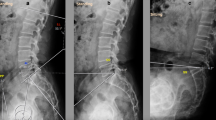Abstract
Background
Optimal acetabular cup position is an important determinant of the success of total hip arthroplasty (THA), and navigation systems have been developed and applied to improve placement precision. However, the registration method touching bony landmarks through soft tissues may decrease the accuracy in obese cases and in patients with acetabular dysplasia.
Methods
Placement accuracy in 69 joints in which THA was performed with imageless navigation was calculated by comparing the placement angle in the anterior pelvic plane and the placement angle in the x-ray table plane with the patient in the supine position. We defined the difference between the placement angle in the anterior pelvic plane and the angle displayed on the navigation screen as the error and the difference between the placement angle in the plane of the x-ray table and the target angle of acetabular component position as the difference in target angle. Patients were divided into obese (BMI ≥ 25) and nonobese (BMI < 25) groups and into acetabular dysplasia and nondysplasia groups.
Results
The mean ± SD navigation errors for all cases were 2.4° ± 2.0° for inclination and 3.7° ± 2.3° for anteversion. The mean difference in target angle for all cases was 2.8° ± 2.5° for inclination and 4.2° ± 3.0° for anteversion. The error in anteversion was significantly higher in the obese group (4.8° ± 2.5°) than in the nonobese group (3.2° ± 2.6°) (P = 0.01). No significant difference was observed between the acetabular dysplasia and nondysplasia groups.
Conclusions
Imageless navigation can be performed with an error of approximately 3° at the anterior pelvic plane. However, accuracy was found to decrease in obese cases.
Similar content being viewed by others
References
Lewinnek GE, Lewis JL, Tarr R, Compere CL, Zimmerman JR. Dislocation after total hip-replacement arthroplasties. J Bone Joint Surg Am 1978;60:217–220.
Ohashi H, Matsuura M, Okamoto Y, Okajima Y. Intra- and intersurgeon variability in image-free navigation system for THA. Clin Orthop 2009;467:2305–2309.
Oinuma K, Christoph E, Saito Y, Shiratsuchi H. Total hip arthroplasty by a minimally invasive, direct anterior approach. Oper Orthop Traumatol 2007;3:310–326.
Meneghini RM, Pagnano MW, Trousdale RT, Hozack WJ. Muscle damage during MIS total hip arthroplasty: Smith-Peterson versus posterior approach. Clin Orthop 2006:453:293–298.
Nogler M, Mayr E, Krismer M, Thaler M. Reduced variability in cup positioning: the direct anterior surgical approach using navigation. Acta Orthop 2008;79:789–793.
Lusty PJ, Watson A, Tuke MA, Walter WL, Walter WK, Zicat B. Orientation and wear of the acetabular component in third generation alumina-on-alumina ceramic bearings. J Bone Joint Surg Br 2007;89:1158–1164.
Malik A, Maheshwari A, Dorr LD. Impingement with total hip replacement. J Bone Joint Surg Am 2007;89:1832–1842.
Udomkiat P, Dorr LD, Wan Z. Cementless hemispheric porouscoated sockets implanted with press-fit technique without screws: average ten-year follow-up. J Bone Joint Surg Am 2002;84:1195–1200.
Dickob M, Martini T. The cementless PM hip arthroplasty. J Bone Joint Surg Br 1996;78:195–199.
Sutherland CJ, Wilde AH, Borden LS, Marks KE. A ten-year follow-up of one hundred consecutive Muller curved-stem total hip-replacement arthroplasties. J Bone Joint Surg Am 1982;64:970–982.
Kojima S, Kobayashi S, Saito N, Nawata M, Horiuchi H, Takaoka K. Morphological characteristics of the bony birth canal in patients with developmental dysplasia of the hip. J Orthop Sci 2001;6:217–222.
WHO Expert Consultation. Appropriate body-mass index for Asian populations and its implications for policy and intervention strategies. Lancet 2004;363:157–163.
Siguier T, Brumpt B. Mini-incision anterior approach does not increase dislocation rate. Clin Orthop 2004;426:164–173.
Nishihara S, Sugano N, Nishii T, Ohzono K, Yoshikawa H. Measurements of pelvic flexion angle using three-dimensional computed tomography. Clin Orthop 2003;411:140–151.
Murray DW. The definition and measurement of acetabular orientation. J Bone Joint Surg Br 1992;75:228–232.
Crowe JF, Mani VJ, Ranawat CS. Total hip replacement in congenital dislocation and dysplasia of the hip. J Bone Joint Surg Am 1979;61:15–23.
Widmer KH, Zurfluh B. Compliant positioning of total hip components for optimal range of motion. J Orthop Res 2004;22:815–821.
Dorr LD, Malik A, Wan Z, Long WT, Harris M. Precision and bias of imageless computer navigation and surgeon estimates for acetabular component position. Clin Orthop 2007;465:92–99.
Najarian BC, Kigore JE, Markel DC. Evaluation of component positioning in primary total hip arthroplasty using an imageless navigation device compared with traditional methods. J Arthroplasty 2009;24:15–21.
Jenny JY, Boeri C, Dosch JC, Uscatu M, Ciobanu E. Navigated non-image-based positioning of the acetabulum during total hip replacement. Int Orthop 2009;33:83–87.
Kalteis T, Handel M, Bathis H, Perlick L, Tingart M, Grifka J. Imageless navigation for insertion of acetabular component in total hip arthroplasty. J Bone Joint Surg Br 2006;88:163–167.
Babisch JW, Layher F, Amiot LP. The rationale for tilt-adjusted acetabular cup navigation. J Bone Joint Surg Am 2008;90:357–365.
Parratte S, Argenson JNA. Validation and usefulness of a computer-assisted cup-positioning system in total hip arthroplasty. J Bone Joint Surg Am 2007;89:494–499.
Rousseu MA, Lazennec JY, Boyer PB, Mora N, Gorin M, Catonne Y. Optimization of total hip arthroplasty implantation. J Arthroplasty 2009;24:22–26.
Lee YS, Yoon TR. Error in acetabular socket alignment due to the thick anterior pelvic soft tissures. J Arthroplasty 2008;23:699–706.
Spencer JM, Day RE, Sloan KE, Beaver RJ. Computer navigation of the acetabular component J Bone Joint Surg Br 2006;88:972–975.
Author information
Authors and Affiliations
About this article
Cite this article
Tsukada, S., Wakui, M. Decreased accuracy of acetabular cup placement for imageless navigation in obese patients. J Orthop Sci 15, 758–763 (2010). https://doi.org/10.1007/s00776-010-1546-1
Received:
Accepted:
Published:
Issue Date:
DOI: https://doi.org/10.1007/s00776-010-1546-1




